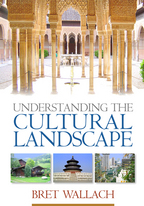Understanding the Cultural Landscape
Bret Wallach
HardcoverPaperbacke-bookprint + e-book
Hardcover
orderJanuary 20, 2005
ISBN 9781593851200
Price: $96.00 406 Pages
Size: 7" x 10"
Paperback
orderJanuary 21, 2005
ISBN 9781593851194
Price: $64.00406 Pages
Size: 7" x 10"
This compelling book offers a fresh perspective on how the natural world has been imagined, built on, and transformed by human beings throughout history and around the globe. Coverage ranges from the earliest societies to preindustrial China and India, from the emergence in Europe of the modern world to the contemporary global economy. The focus is on what the places we have created say about us: our belief systems and the ways we make a living. Also explored are the social and environmental consequences of human activities, and how conflicts over the meaning of progress are reflected in today's urban, rural, and suburban landscapes. Written in a highly engaging style, this ideal undergraduate-level human geography text is illustrated with over 25 maps and 70 photographs.
Note: Visit www.greatmirror.com for many additional photographs by Bret Wallach related to the themes addressed in this book.
Note: Visit www.greatmirror.com for many additional photographs by Bret Wallach related to the themes addressed in this book.
“Understanding the Cultural Landscape is a tour de force—a splendid example of the lively, clear, and attractive writing that scholarly prose should be, but so seldom is. Bret Wallach, one of America's most distinguished geographers, has revived a noble but long-neglected tradition of cultural geography, deeply rooted in history and an amazing range of geographic facts. For intellectually curious students of the human condition, this is a profoundly important book.”
—Peirce F. Lewis, Department of Geography (Emeritus), Pennsylvania State University
“This book is filled with interesting insights, illuminating the continuing importance of actual geography even in the homogenizing twilight of globalization.”
—Bill McKibben, author of The End of Nature
“Most texts in human geography are eye-glazers, room-emptiers. This one emphatically is not. Bret Wallach ranges back and forth across time, space, and scale to bring us this generation's definitive globalist human geography. Imaginatively conceived, sharply detailed, and wonderfully written, the book will work at almost any university level and for intelligent general readers too. All by himself, Wallach may succeed in bringing geography back into the intellectual mainstream. In a word, this book is fabulous.”
—Frank J. Popper, Urban Studies Program, Rutgers, The State University of New Jersey
“An astonishing achievement! I doubt whether we shall ever see a more useful, thought-provoking account of what our humanized world is really like and how it came to be. Highly readable and informative, this is geography for thoughtful readers at its best.”
—Wilbur Zelinsky, Department of Geography (Emeritus), The Pennsylvania State University
Table of Contents
1. IntroductionI. Anthropological Foundations
2. Human Evolution, Diffusion, and Culture
3. Foragers
4. Domestication
5. The Diffusion and Early Development of Agriculture
6. The Emergence of Civilization
II. Historical Developments
7. China
8. India
9. A Technological Civilization
10. Globalization
III. Livelihoods Today
11. Resource Production
12. Manufacturing
13. Services
14. Transportation and Communication
IV. Social and Environmental Consequences
15. Romantic Responses
16. Political Reactions
17. Conservation, Resources, and Population
18. Pollution, Biodiversity, and Climate Change
V. Reading Landscapes
19. American Cities
20. Rural America
21. Cities Abroad
22. Countrysides Abroad
